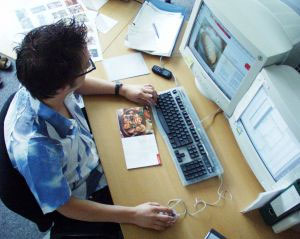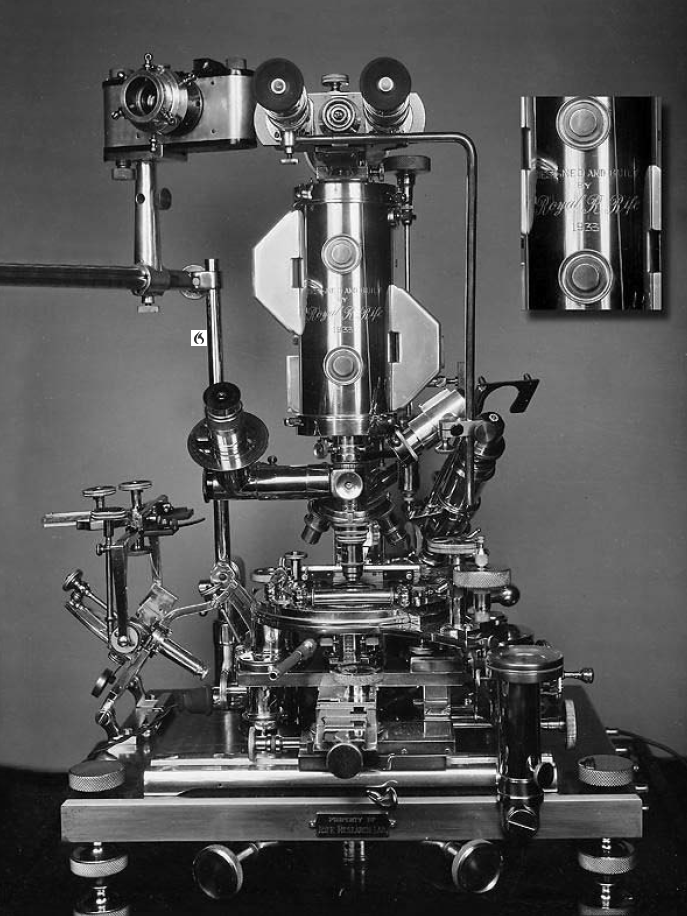Occupational Injury In The Office – Computer Radiation Danger
Are chemicals in computers the explanation for electric sensitivity?
An interview with Swedish journalist and author Gunni Nordstrom whose work over two decades is a unique contribution to the history of Occupational Injury.
August 3, 2001
Most journalists’ assignments are short term. Gunni Nordstrom’s assignment has lasted almost two decades.
It was not at all popular among employers and manufacturers that their workers became ill from the computer monitors placed on their desks. It started in the 1970’s but the real epidemic came in the 1980’s when office workers, in those days mostly women, began to be placed in front of computer monitors. Many of them became ill and developed skin and neurological problems. It was a direct threat especially to the electronics industry. While our well paid health officials tried to ignore the electrically sensitive victims, Gunni Nordstrom, like Agatha Christie’s determined Miss Marple, kept her ears wide open. She never stopped asking questions and she has been busy ever since putting into place the many pieces of a complicated jigsaw puzzle.
In her latest book she reveals that chemicals from computer monitors can explain a great deal of the suffering. There are sufferers all over the world. In the U.S.A. they tend to focus on the phenomenon called MCS (Multiple Chemical Sensitivity) and in Sweden on ES (Electrical Sensitivity) Gunni Nordstrom suggests that may be we are dealing with the same phenomenon that has been given different names.
Multiple chemical sensitivity, chronic fatigue, and electric sensitivity may be different names for basically the same problem.
Her interest in the often tragic fates of the many electrically sensitive people she has come in contact with (they have very often been without any recourse to justice) has been her driving force. She has been important to the electrically sensitive in Sweden and abroad in that she has described their difficult situation and the many attempts at covering up their problem. At the same time she has relentlessly followed a series of leads that hopefully will explain why so many people have become electrically sensitive in our modern office environment.
Gunni Nordstrom has done us all a service in writing an important chapter in the history of Occupational Injury.
FEB:
When did you first start writing about people who became ill after using computer monitors?
GUNNI NORDSTROM:
I was the first to write about this affliction (in the TCO Newspaper in Stockholm, Sweden) in October 1985. But the problem did not start then. It had existed for at least 5 years, without anyone having investigated it in depth.
The reason that I started my investigation was that a bank employee had received work injury compensation for skin changes after working in front of a computer monitor. She (it was mostly women in those days who worked with computers) had a doctor’s certificate from the histopathologist Bjorn Lagerholm. He described in great detail her skin changes, which were of a kind that he had previously seen only in connection with ultraviolet light and X-ray damage. It is to be noted that Bjorn Lagerholm had unusually large experience in examining skin biopsies under a microscope. He was not only head skin doctor at the Karolinska Hospital in Stockholm, and at the same time, a histopathologist – an unusual combination – he also had a private practice. He had examined at least 10,000 biopsies when he wrote this important affidavit for this woman. He obviously knew what he was talking about when he explained that this woman and a series of other individuals (also computer users) he had examined, had the same skin changes.
A debate followed, and Bjorn Lagerholm wrote an article in the Swedish Medical Journal to explain his observations. The observations covered young individuals (of both sexes) that had been working in front of computer monitors. He had found remarkable changes in their skin considering their age; elastosis solaris at a very young age, after only a few years of working in front of a computer monitor, was not normal. Such changes he usually would find in farm workers or sailors who had been exposed to sun all their lives.
FEB:
How was your first article received?
GUNNI NORDSTROM:
My article about the bank employee was like letting the cork out of a ketchup bottle. The phone would not stop ringing. People called from all over the country. They said that they felt like they had been lying in the sun too long (and they had only been working with computers). Their skin was taut and burning. Now they had to wear sunglasses and wide hats or caps for protection against the sun. They had become light sensitive. This is an important observation that must not be overlooked. Skin doctors and others have overlooked this phenomenon. In my meaning, the light sensitivity is the most important clue to explaining the cause of electric sensitivity.
FEB:
Is sensitivity to light still ignored?
GUNNI NORDSTROM:
I will give a very recent example: The Swedish Work Environment Fund had been requested by the Swedish government to deliver a report on electromagnetic sensitivity. Only one line in this report mentioned light sensitivity. The experts had asked for input from the electrically sensitive. They received 400 letters that spoke clearly: Light sensitivity was one of the most prominent symptoms. What did the experts do with the letters? They threw them into a card box and delivered them to the government and claimed that nothing could be learned from them. But the truth will out sooner or later. The letters are presently being compiled into a book by private means.
FEB:
The unions and the TCO Newspaper were evidently quite influential in bringing forth the symptoms their members got after using computer monitors. Any negative reactions?
GUNNI NORDSTROM:
The union ombudsmen were at that time a great source of irritation to the many “experts” of the establishment. Ms. Kajsa Vedin from Gothenburg wrote a brilliant report “In the shadow of a Microchip” which predated my first article and was an excellent and intelligent analysis of the risks involved with computers. Before that, the unions had embraced this new technique without any thoughts of possible health risks.
What we wrote in the TCO Newspaper was carefully monitored and the “experts” tried to attribute the phenomenon to unions who, they said, had “taught” their members what symptoms to report in order to get work injury compensation benefits. We journalists and the union ombudsmen were considered troublemakers.
FEB:
How did you deal with the suggestions that the press caused the problem?
GUNNI NORDSTROM:
I did not accept that explanation. Early on I realised that something important was buried and this had to be dug up and brought out into the open. That is why I have stubbornly continued to write about this question. I simply was not convinced that the reason for the computer monitor illness was imagined or press-influenced. One does not become light sensitive for psychological reasons. And how could people all over the world, independently from one another, get the same symptoms from computer monitors?
FEB:
We recently heard from an Irish woman who, when seeking help for her electric sensitivity, had to submit to treatment at a mental hospital. Has this happened in Sweden?
GUNNI NORDSTROM:
Yes, it certainly has. And it happens in Finland all the time. In my second book, (Faltslaget om de eloverkansliga) I describe a man who got ill in 1979. There was no debate about computer monitors in Sweden at that time, but he was convinced that it was his work as a computer teacher that had made him ill. Every time he turned the computer on, he got his symptoms – very typical symptoms. He was taken to a psychiatric ward for an evaluation. He was locked up until the examination was over. He really should demand compensation. He got so fed up with Sweden that he moved to Spain.
Doctors at that time declared that one could not get sick from computer monitors. They could not even entertain the thought that a computer monitor contained something that could give people negative symptoms. I often think of these so called experts now, when the many pieces are falling into place.


FEB:
Talking about things falling into place. A computer monitor emits electromagnetic fields. This is well known to most people. But what is less well known is the fact that it also contains harmful chemicals (used as flame-retardants) that are released, to the greatest extent, when the monitor is new, and later, during usage, in small doses. Many people work in crammed offices with poor ventilation, surrounded by electronic equipment giving off chemicals. What is the significance of these chemicals that we breathe in from the computer and other electronic equipment?
GUNNI NORDSTROM:
We are talking of chemicals that are hormone affecting and are being accumulated in the body. This is the work environment problem of today and tomorrow. There are so many people affected that our authorities are trying to obfuscate the truth. That is why I called my latest book “Cover Up”.
The most important effect is perhaps the fact that certain chemicals can cause chronic light sensitivity. I put forward this hypothesis in “Cover Up”. The hypothesis was originally presented by Mr. Per Hedemalm, an environmental consultant in Gothenburg who probably could have resolved the question in 1990 had he been given proper funding.
FEB:
Could you mention the name some of the chemicals that are to be found in computers?
GUNNI NORDSTROM:
The brominated flame-retardants have been discussed a lot the last few years. We know that until a few years ago it was very common with PBDE (polybrominated diphenolethers) in the plastic casings of computer monitors and computers. The debate contributed to the removal of PBDE in the plastic casings.
But this does not solve the problem with flame-retardants in computers. In almost all computer chips we still have TBBPA (tetrabromobisphenol A). This is often ”forgotten”. Not even TCO has demanded the removal of TBBPA. They have been cowardly in this instance. There is simply no economical substitute today.
The computer chips are built on plates or cards that contain epoxy. In my book I describe the epoxy components, where bisphenol A, in particular, in combination with light, is suspected of creating chronic light sensitivity.
But there are many more chemicals in electronics. IBM revealed in 1990 that hundreds of chemicals were released from their computer monitors. There is often the talk of ”safe” levels, but as regards chemicals stored in the human body; one cannot talk about safe levels. We know nothing of how chemicals and electromagnetic radiation work in unison.
FEB:
You mention that these chemicals besides being toxic affect our hormones.
Considering the fact that breast cancer still is on the increase and there appears to be no explanation for this, could the explanation be found in these hormone-affecting chemicals we are exposed to in front of our computers?
GUNNI NORDSTROM:
You will have to speak to the cancer researcher Lennart Hardell at the university of Orebro, Sweden. He has studied the effect of cancer and chemicals, particularly flame-retardants.
FEB:
Helmut Kohls wife recently committed suicide due to a severe and lengthy light sensitivity condition. She had to remain in total darkness and could never go out. Many electrically sensitive have experienced precisely the same light sensitivity after their work with computers. You have interviewed a great number of electrically sensitive individuals, how common is this severe light sensitivity?
GUNNI NORDSTROM:
Light sensitivity as such is very common among the electrically sensitive, one of the very earliest symptoms actually. The severe case of light sensitivity that Hannelore Kohl suffered is rare, but such cases do exist. I read about a German dermatology professor who said that such severe light sensitivity ”does not exist” except in cases with inherited light sensitivity (xeroderma pigmentosum). Yet I have come across or heard of many similar cases in Sweden and Finland. In my book I write about Swedish professor Olle Johansson’s description in a scientific publication of a woman who became so sensitive after working with a computer that she had to live in total darkness. He took skin biopsies and could show that while her light sensitivity lasted, the cells in her skin that normally protect the skin against radiation were completely gone! The German dermatology professor appears not to be very well updated.
I describe in my book about a woman, who after computerwork, was forced to live in total darkness in her parents home in Finland. The doctors ridiculed her and said she suffered from the ”Swedish disease”. If Mrs. Kohl was treated with the same lack of understanding, I can understand her desperation.
FEB:
You lead us through complicated, but luckily easily understood chemical discussions. Do you have any background in chemistry?
GUNNI NORDSTROM:
I am unfortunately not a chemist. In the Swedish school in Finland that I went to, I never gave chemistry much attention unaware that I one day bitterly would regret this. The ideal constellation of experts to solve this problem would be a chemist, a toxicologist, an expert in electromagnetic radiation, a neurobiologist and a journalist. I do not have their expert knowledge but they, on the other hand, do not have as detailed knowledge of the patients as I do.
FEB:
What lead you to studying chemicals?
GUNNI NORDSTROM:
I believe that chemicals are the missing link.
I had come to believe that there must be some enhancing factor (to the electromagnetic fields from the computer monitor) that could explain why people became hypersensitive from using computers. The missing link is chemicals that react with light and can cause light sensitivity. I believe the chemicals are toxic and photo toxic.
In my latest book I write about Per Hedemalm’s hypothesis that certain chemicals in a computer monitor can cause photo-allergy or photo-toxic reactions. In other words, light dermatosis. Light is a kind of electromagnetic radiation so this observation is most relevant. As Per Hedemalm, points out, from sensitivity to light to sensitivity to other electromagnetic radiation, the line is very thin.
FEB:
If some of the users of computers have got ill from using them, what about the people, who manufacture them, have they also got ill?
GUNNI NORDSTROM:
Joseph LaDou, a work environment expert from California visited Stockholm in the 1980’s and told how people in the computer manufacturing industry in Silicon valley suffered from a mysterious illness which appeared to be a total exhaustion of the immune system. My coworker Carl von Scheele interviewed him and when I read the article, I understood that this was something important but I could not quite put my finger on it just then.
I saved the article and later I learned of the Silicon Valley syndrome, which was exported to southeast Asia, when the manufacturing was moved there. People got ill in perfectly sterile rooms where computer chips were made. Joseph LaDou did not hesitate in pointing at the specific chemicals used in computer chips manufacturing.
We know that in the manufacturing of semiconductors in Silicone Valley, people have in some cases got chronic conditions such as total allergy, and we also know that those who sort and scrap electronic products have high levels in their blood of flame-retardants. Yet when the users of these products in the middle phase get symptoms similar to those in Silicone Valley, then there is an absolute tabu to speak of what chemicals our electronic products contain. That is what my book is about. I point to clear relationships that may exist.
FEB:
Why do you think IBM in Sweden made a study of the chemicals (they found 50 different chemicals) in their computer monitors when so many people got sick from working with their monitors?
GUNNI NORDSTROM:
IBM had had problems with their employees in their manufacturing. They knew there was something wrong and they were decent enough to find out, but it was probably not their intention that the report would leak to the press.
FEB:
Why does a journalist explain all this to us? Why do we not get this from our “experts”?
GUNNI NORDSTROM:
This is precisely why I write. I think things should be described in a correct and accurate time-frame. I also write to expose the money-making fraud in this business. These so called experts have enriched themselves on taxpayers money and have even written doctoral theses based on sheer nonsense.
FEB:
Could you give us an example of “expert” mismanagement and other attempts at cover-up?
GUNNI NORDSTROM:
A very recent example: Sweden has three prominent experts at the university of Lund who have shown that microwaves open the blood brain barrier on rats. Their findings have been world news, but the experts (The Swedish Work Environment Fund had been requested by the Swedish government to deliver a report on present research in electromagnetic fields) chose to virtually leave out these most alarming findings, they were only mentioned perfunctorily.
No one from the government has contacted the scientists either.
The government has similarly been mislead regarding the findings of professor Olle Johansson of the Karolinska Institute in Stockholm. His findings regarding skin changes concerning mast cells and electromagnetic fields are extremely important
The government seems to listen to those who have the right message, the message they wish to hear. Sometimes one wonders if the authorities have these reports custom-made or if someone in the background is masterminding all important positions and is handing out investigations to those with the correct beliefs or to the untalented. The independent thinkers get their heads chopped off as soon as possible at any rate.
FEB:
One of the experts you mentioned is Dr. Lena Hillert. You devote an entire chapter to her in your latest book. She is generally known for trivialising electric sensitivity and her language, when discussing mobile phones, very much resembles that of industry representatives. You have both listened to many electrically sensitive individuals, yet you have come to vastly different conclusions. Why?
GUNNI NORDSTROM:
It appears that Lena Hillert does not have an inquisitive mind. She does not combine the patients descriptions in a logical manner. I can agree that the patients sometimes can draw the wrong conclusions as regards certain details, but essentially, they do not make things up. They are ill and they are correct that their problem has something to do with their work environment.
On the other hand, not many of the electrically sensitive seem to understand the link to the chemicals in their computer monitors. Lena Hillert, who is an expert should have understood this, and should have initiated research in this area. But then she would not have received funding for her psychological studies; also she would not have been quite so popular with mobile phone operator Telia Mobile, who probably pays her and others handsomely for being on their “scientific expert panel”.
FEB:
You worked for a union newspaper. Yet you have often criticized the unions for not taking their responsibility. Have you made yourself unpopular in your own back yard?
GUNNI NORDSTROM:
Probably. I do not care. If they are so ignorant that they do not understand this issue, or so lazy that they do not have the energy to get engaged, then it is their problem. But unfortunately the real sufferers are their members. But I must say that the Swedish unions have been fantastic in comparison to the Finnish unions who are afraid to appear foolish in front of the researchers and experts who try to put a psychological label on those suffering from the effects of computers and other electronic devices. They have left their members in the lurch in a truly scandalous way.
FEB:
Is this due to the NOKIA presence in Finland?
GUNNI NORDSTROM:
Undoubtedly yes!
FEB:
Another lead that you refuse to let us forget is what happened at the factory SVENSKA FLAKT in Sweden. The factory has since long closed and the injured workers live peacefully with government pensions. Why should we not forget this incident?
GUNNI NORDSTROM:
The Svenska Flakt incident occurred shortly before the epidemic of injured office workers who had been working with computers. And both groups had been exposed to decomposed components from epoxy and they showed similar symptoms. The Svenska Flakt case concerned men and they quickly were awarded work injury compensation.
When the same thing happened to office workers (mostly women) who also were exposed to decomposed components of epoxy (which in their case came from the computer monitors), then the realisation soon emerged that all these people could not possibly be awarded work injury compensation. There were simply too many. I have been told by a skin doctor to stay away from the Svenska Flakt case for fear of jeopardising the work injury compensation already awarded.
FEB:
The Swedish scientists Salford, Braun and Persson, have discovered that very low levels of microwaves can cause the brain blood barrier to let in toxins that definitely do not belong there. How does this finding fit in with your theory about electric sensitivity?
GUNNI NORDSTROM:
There are frequencies up to the microwave range in computers also. We know that very low level microwaves open the blood-brain barrier. The combined action between chemicals and electromagnetic fields is a highly interesting area. However there are no studies performed on those who got ill in front of computers with this aspect in mind.
If we have a modern office environment with a lot of electronic products giving off toxic chemicals, and simultaneously, wireless equipment, giving off microwaves, it is evident that this combination is not healthy. How dangerous this situation is, remains to be seen. We must not forget that there are far too many people who have got ill for us to ignore this problem.
FEB:
Your memory and ability to see important things in matters that pass most people by, is impressive. So are the many case studies you present. There is one particular case, a 33 year old man, Anders Lindstrom, who worked for Ericsson Radio System in Gavle, Sweden. His work with mobile phone base stations exposed him to microwaves and chemicals. Today he is almost totally blind and severely handicapped. Yet he has not received any compensation from anyone. It appears that the establishment, doctors included, unanimously declared that the injuries he had suffered “could not possibly have come from his work place”. This despite the fact that he was exposed to microwaves close to his eyes.
The subtitle to your third book COVER UP is “The victims of electronics – without recourse to justice”. Would this man not have had a better chance of obtaining justice with the American judicial system? Has any other country undermined their work injury compensation insurance to the extent as they have in Sweden where you, these days, must have a very obvious physical accident to get a chance of being compensated?
GUNNI NORDSTROM:
A private lawyer with the good sense of procuring the best experts could have done wonders for this man in the U.S.A. The unions in Sweden have been timorous in dealing with Ericsson.
The Swedish Work Injury law was a good idea at one time. Now it has been diluted. The unions should consider this. Soon they will have a flood of people injured at the workplace and they will revolt against the unions when they discover that they are not able to get any work injury compensation.
FEB:
Before we end, please tell us what happened to the bank employee whose fate got you interested in this matter in October 1985. Did she get to keep her work injury compensation for the injury she had suffered in front a computer monitor, or was there an appeal? Since she was the first to be awarded work injury compensation, and there were many similar cases, her case would be a precedent if it was upheld. What sort of help did she get from her union?
GUNNI NORDSTROM:
She got help from her union, but this help was lacking. Without her own efforts, the case would not have been as interesting. She was much better updated than her counsel. The insurance courts had to get the best experts in the land to counter the doctor certificates and all the material she had collected herself.
The remarkable thing in this case is that Doctor Bjorn Lagerholms certificate was not questioned in any way. No one dared to question such a skilled histopathologist. On the other hand, it was stated that computer monitors could not have caused the injuries he had seen. The experts did not deny that there was a direct relationship in time between the injuries to the woman’s skin and her work with the computer. But the sacred computer could not be the culprit.
This battle took ten years. During this time, there was an accumulation of other cases in the lower courts. When this verdict came in the highest insurance court, it was a political decision. What would society do with a lot of people claiming to be ill from their work with computers? The chemical industry had nothing to fear. The cover-up had worked.
FEB:
What are your plans for the future?
GUNNI NORDSTROM:
I am presently reworking my book for the English translation. I am very interested in the reactions from those suffering from multiple chemical sensitivity and chronic fatigue in various countries. But foremost I hope that there will be readers with a better knowledge of chemistry who can continue my work. I am an investigating journalist, not an expert in chemistry. It is time for toxicologists and others to take over.
Those who wish to write to me with their observations or comments are welcome to do so to the address below:
Gunni Nordstrom
Granskogsvagen 2C No 9
FIN 64100 Kristinestad
Finland
Books by Gunni Nordstrom
SJUK AV BILDSKARM
(Ill from Computer Monitors).
Cowriter Carl Von Scheele
Publisher Tiden /TCO-tidningen 1989
ISBN: 91-550-3484-5
FALTSLAGET OM DE ELOVERKANSLIGA
(The battlefield of the electrically sensitive)
Cowriter Carl Von Scheele
Publisher: Tiden. Stockholm Sweden 1995
ISBN 91-550-4083-7
MORKLAGGNING. Elektronikens rattslosa offer.
(Cover Up. The victims of electronics – without recourse to justice)
Publisher: Hjalmarsson & Hogberg, Stockholm Sweden 2000
ISBN: 91-89080-41-6
Copyright FEB August 2001




